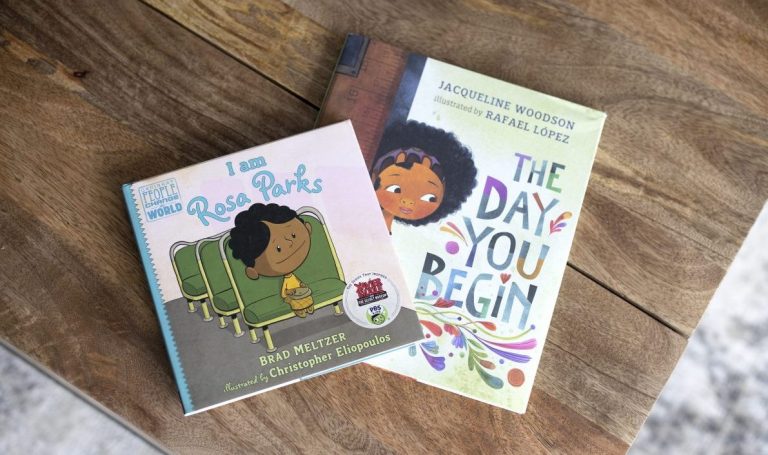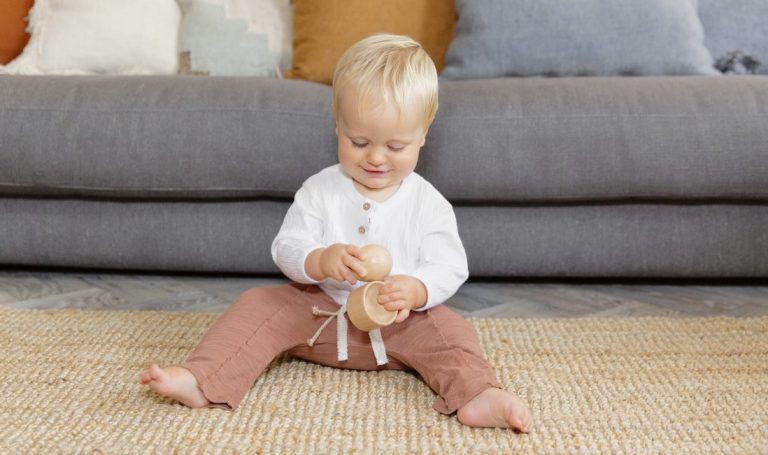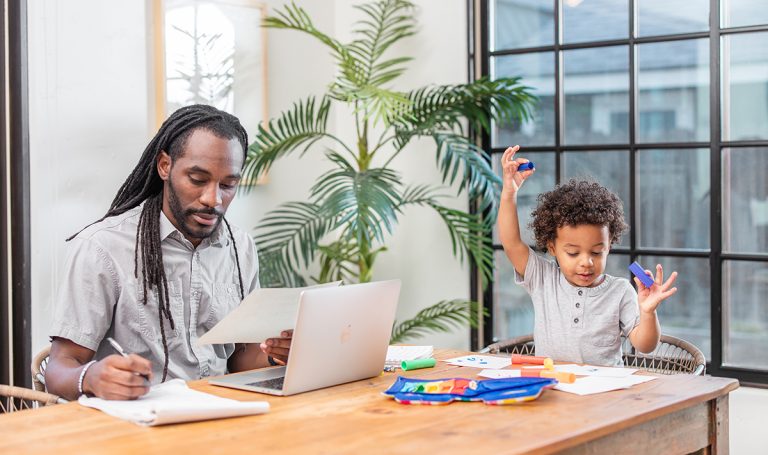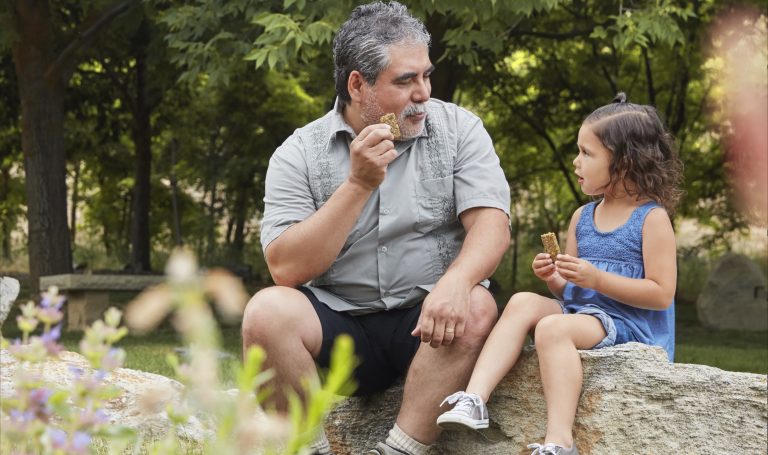0 - 12 Months
How soon should children learn numbers & math?

“You’re just mentioning numbers, mentioning easy things that are already in their environment. You’re just pointing things out, you’re not responsible for teaching them big complex mathematical concepts.”
Dr. Gillian Starkey, professor in neuroscience
We all know how important it is to read to our children, but trying to build a baby’s math skills can feel like a challenging task, especially if we don’t have a positive association with math ourselves.
The good news is, baby is encountering math everywhere, and nurturing a love of numbers is not as hard as commonly thought. After all, we are all born loving numbers!
In this episode, Jessica Rolph speaks with Gillian Starkey, a professor in neuroscience with an emphasis on children’s developing math skills. She shares some pointers that are going to score big with you and your baby, and might even make math into something you both look forward to.
Key Takeaways:
[1:22] What constitutes math for babies?
[2:45] Gillian shares why it is important to build basic math skills at home with our babies.
[3:51] What do babies know about math when they are born?
[4:49] Activities that you can do with your baby (0-12 months old) to build math skills.
[8:00] How do children’s understanding of numbers and what they represent evolve as they get older?
[9:01] Gillian explains how to engage toddlers in everyday math.
[10:03] Baking is one great way to introduce mathematical concepts to toddlers.
[10:33] Shapes and patterns can be used to strengthen math skills.
[11:40] Gillian gives tips on how to deal with our own math anxiety.
Mentioned in this episode:
Learn more about Gillian Starkey
Transcript:
Math for babies
Jessica: So when we talk about math learning and early childhood, what are we exactly talking about? What constitutes math for babies?
Gillian: Yeah, so I think when people in general think of math, a lot of us think of computation and algebra, and things that we feel like kids that young are nowhere near ready for. But I think that all begins with just an understanding of what numbers represent. And so when we talk about math with young children, and particularly with infants, we’re talking about like a familiarity with number words and concepts like none or more or less, bigger and smaller, and a lot of things that they encounter naturally in their environments like shapes can be used to teach those concepts at a really young age.
Jessica: I had wondered too about sequences. So when you do a routine with your baby and you name the order of the steps in that sequence, does that constitute math?
Gillian: Yeah, certainly. So sequences are mathematical, patterns are mathematical. So if you have a shirt or a carpet that has red and black stripes, point out that red and black pattern because that is inherently a mathematical concept that they are learning.
Importance of math in the early years
Jessica: I remember when I first met you, I was just so blown away by thinking about math for my baby and it’s something that I really did associate with school, with the classroom, pre-school. So why is it so important to build these basic number skills at home with our babies?
Gillian: So we know that when kids start school, they’re using numbers a lot more, at least explicitly using numbers a lot more than they have in the previous few years of life. But what really helps with this is already having some associations and pathways and connections in the brain between what the number two sounds like as a word and what it actually represents; two objects, and what you can do with those two objects, like you can put one out, and then you can put another one out, and then you have two. So things like that build the foundation for children to be able to really quickly grasp number concepts when they start school.
Jessica: Yeah, and it’s so interesting, because I think that as parents, we think reading, we should always be reading to our babies. And there’s so much around early literacy, but there really isn’t as much about early math, which is why I’m so glad to have you here with us. What do babies know innately about math when they’re born, or what do they actually understand, let’s say an infant between zero and one, what do they know when they’re born?
Gillian: So there have been studies that show that infants are surprised when they see one thing move behind the screen, and then another thing move behind the screen, and then the screen is removed, and there’s only one thing, they realize that that doesn’t make sense. And so they inherently understand the difference between one thing and two things, and that might seem like not much because they’re just very small numbers, but if you scale up, if you talk about big quantities of things, they can also tell the difference between very, very large quantities as long as they follow a certain ratio. So as long as one group of things is twice as big as the other, they can tell that that’s bigger.
How to build math skills in infants
Jessica: What can we do to build math skills in our infants? So, let’s imagine from zero to one, what are the favorite things that you’re doing with Oliver right now?
Gillian: So, one thing I’m doing is I’m counting everything with him. There’s a book that we read, and this kind of gets back to your point Jess, about focusing on books and literacy, and feeling like you might be neglecting math, but there are so many ways to work math into the books you read, or they might… These concepts might already be in the books you’re reading. So for example, I have a book that I love to read Oliver, called, “I love you through and through,” and it talks about body parts like, “I love your ears and nose” and so I’ll count Oliver’s ears, you can point them out on the page and say, “One ear, two ears,” and then I touch his ears, and I say, “One ear, two ears.” So even in the context of reading a bedtime story, there are ways that you can include math. So, I’m counting to him, I count his fingers when I clean oatmeal off his fingers in the morning, I let him play with things that are different shapes. So he plays with Lovevery’s first puzzle, which is a round piece of wood embedded in a square block, and you pull out the round piece, and so he sees the difference and shapes are mathematical too. I also point out things on our walks. So if we see a group of ducks, I’ll point out there are four ducks, “One, two, three, four. Four ducks.”
Gillian: And so, he sees that these are things that exist in nature as well, all the time. And one thing that I think is worth talking about is, there’s research on children who are able to notice and pay attention to things in their environment that had numerical properties, tend to go on to be more comfortable and feel more fluent with math skills. So modeling that attention to number in your environment is a really good way to start.
Count everything
Jessica: Do you mean Gillian, that you are saying that we are, if we just as parents, if we just count things, like we’re counting the ducks, we’re counting the pages, we’re counting their fingers, that that’s actually introducing numeracy into their environment?
Gillian: Yes, because what it’s doing is, it’s showing them… First of all they hear that there’s a certain sequence that number words follow, and that’s really important for later when they start to count things by themselves. They also see that the number three for example, is paired with, “Oh, that was one, two, three fingers,” or, “One, two, three, crackers.” So they see, they build these associations between, what they’re seeing, the quantity of things that they’re seeing with the number word, the sound of the number word and the sequence that you went through to get to that number word.
Understanding numbers throughout childhood
Jessica: So parents have this thing where they’re like, “Is my child actually getting it? Shouldn’t they be counting?” Let me ask that again. So I always wondered with my toddler when he would count, he would put his finger and he would count just like I count on the page, but sometimes he would jump around to different numbers, he’ll be like, “One, two, five, six… ” And then he wasn’t actually pointing to the objects on the page as a… He wasn’t counting that one strawberry in the page, and then that second strawberry in the page, and that third strawberry in the page. Can you talk a little bit about how children’s understanding of these numbers, and then what they’re actually counting evolves as they get older?
Gillian: Yeah, so this is a normal and totally adorable phase [chuckle] that they go through where they have started to repeat number words, which is great, they’re starting to internalize those number words, they might even know the right sequence of number words, and that’s a great step toward counting. And eventually when they’re around three, they learn what’s called one-to-one correspondence, which is that for every number word, you point to a thing, and so you pair one number word with one item. And before that, you’re right, they might be skipping over things, they might be double counting, counting some things twice, and that’s completely normal, and eventually they will learn to pair one number word with one item, and then they’re really counting. And once they’re able to count to three, then the next time, they might be able to count to four, and then to five.
Toddler activities involving math
Jessica: Speaking of toddlers, how can we think about introducing math in our toddler’s environment? Is music… Does that connect to number sense? How do you think about activities that you can do with your toddler to bring math to the forefront?
Music can be mathematical
Gillian: So yes, music can be very mathematical. For example, if you can hear and feel the difference between 4/4 time, one, two, three, four beats versus a waltz rhythm, which is three beats, that’s mathematical. So one way to do that with a toddler, toddlers love to handle things, they love to bang things, if you have rattles or maracas or some kind of musical instrument, you can bang them to a beat with your toddler and they can feel and hear the difference between those numbers.
Math concepts in the kitchen
Jessica: So fun. And anything in the kitchen? I often think about baking as math, but how would you think about involving your toddler in the kitchen and thinking about math in those moments?
Gillian: Oh, so many possibilities. So there are so many concepts, mathematical concepts involved in baking and cooking, like more and less and counting out how many spoonfuls of something you need…
And then, not only does your toddler get to hear those number words, but they may actually get to move the spoonfuls over to the bowl them self in a very, probably messy way.
Notice shapes and patterns
Jessica: And how do you think about shapes in a toddler’s environment? Can you give us parents some ideas of how we might notice shapes or notice patterns every day with our little people?
Gillian: Yeah, so if you have one of those puzzles where kids are supposed to fit certain shapes into certain holes, point out, count the number of sides, point out how they’re different from the other shapes, how a triangle is different from a square, which is different from a circle. Drawing their attention to those properties of something fun they’re doing, just a puzzle, is really helpful in terms of getting them to notice number and appreciate that difference between shapes.
Incorporate math in your everyday
Jessica: Okay, so now I’m going to get a little bit more philosophical. So lots of people including me have some degree of math anxiety, what would you say to parents who are just like… I had my own struggles of math in childhood, and I always have this insecurity that I didn’t quite get it. How do we coach these parents into feeling empowered to teach math to their children?
Gillian: It’s a great question, because there have been some recent studies showing that kids really pick up on our anxiety and our emotions about things. And so, if you have anxieties when you’re trying to introduce numerical concepts with your kids, they might notice that. And so, one way to think about it, is just reframe it for yourself. So you’re not doing math time, right? You’re just mentioning numbers, mentioning easy things that are already in their environment, and you’re just pointing things out, you’re not responsible for teaching them big complex mathematical concepts.
Jessica: Gillian, it’s so special to have you with us, and it’s really amazing to have a neuro-scientist that is a new mom. So I would love to hear if you have any advice for all of us.
Gillian: So I would just advise you to remember that your kids’ brains are growing and adapting and absorbing things all the time, and they’re constantly making connections. So while it might feel like here I am telling you that you have to sit down and do math time, or there’s this additional responsibility, something more that you have to fit into what already feels like a really short day, it’s not necessarily that way. So there are a lot of ways to… When you start to think about what math actually is, and all of the things that are mathematical, there are a lot of ways to incorporate that into what you’re already doing.
Jessica: Gillian thank you so much for being with us today. It’s been so fun.
Gillian: Thanks so much for having me.
Episode takeaways
OK, I don’t know about you, but I’m feeling a whole lot more inspired to bring math into my kids’ everyday at home! Here are a few of her tips:
Math is everywhere
Once you start thinking about math in a broader sense, you discover that math is everywhere – counting the sides of shapes, pointing out stripes on your shirt, waltzing with your baby to a 1-2-3 step, counting your baby’s fingers while you clean them… Find excuses to count anywhere with your baby…
Babies have an innate understanding of math
Your baby has an innate understanding of math. They inherently understand the difference between 1 and 2, and they can pick out a larger quantity if it is double the smaller quantity.
Keep it positive
Your positive attitude around numbers and math will rub off on your kid!
For more suggestions on activities that involve your baby with math, go to on Lovevery’s blog, “Here With You.”
Posted in: 0 - 12 Months, Problem Solving, Math, Playtime & Activities
Keep reading

18 - 48 Months+
0 - 12 Months
Lovevery’s Disability Support Service offers personalized guidance
Lovevery’s mission is right in our name—we love every baby and child. Today I’m so proud to say that we’re further realizing that mission, by better serving more families. As you know, our Play Kits are staged by a child’s age. This works for many families, but I know firsthand that it’s not ideal for … Continued

0 - 12 Months
Lovevery Introduces New App for Parents
We’re so excited to introduce our new Lovevery App, free and available to Play Kit subscribers 🎉

12 - 48 Months
0 - 12 Months
Lovevery for Target
Experience our new Target stage-based play essentials, as well as familiar favorites like The Play Gym and The Block Set, straight from your local Target location.

12 - 48 Months
18 - 48 Months+
0 - 12 Months
8 ways to celebrate Earth Day as a family
Earth Day is a time to celebrate nature and the environment. Teach your children how to take care of the Earth with these fun activities, crafts, and books.

0 - 12 Weeks
3 - 4 Months
5 - 6 Months
7 - 8 Months
9 - 10 Months
11 - 12 Months
0 - 12 Months
The complete guide to baby development milestones
We compiled this expert guide to help you know what to expect for your baby's growth and month-by-month development.

12 - 48 Months
13 - 15 Months
0 - 12 Months
Celebrating Black History Month with babies and young children
Children of all races are never too young to take part in Black History Month. Here are ideas on how celebrate with your child, along with a list of books that center Black people and culture.

12 - 48 Months
0 - 12 Months
What are Montessori toys?
Some toys have characteristics that are aligned with Montessori principles. Learn what they are, why they can benefit your child, and how to introduce them.

12 - 48 Months
0 - 12 Months
You can’t balance work and parenting during Covid. That’s OK.
As we continue to adjust to new normals, some things have stayed the same: working while caring for young children during a pandemic is really hard. Here are a few ways to ease the burden.

0 - 12 Months
Diaper bag must-haves from real parents (and yes, all 30 are essential)
We talked to real parents about their must-have diaper bag essentials and on-the-go hacks. The list is extensive but ensures you won't be caught unprepared.

12 - 48 Months
0 - 12 Months
This powerful activity can change your child’s brain
Back-and-forth conversations with your baby have a significant impact on language development and are important for social, emotional, and cognitive growth.
